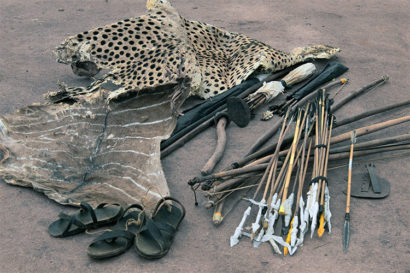Study finds global legalization trial escalates elephant poaching
Does legalization really make black markets collapse? New research looking at ivory trade raises questions.

June 13, 2016

Ivory from elephant tusks are part of a global black market trade. The elephants above were photographed at a Nambian conservation park. (iStock photo.)
Berkeley — Two researchers who examined elephant poaching data and the ivory trade say policymakers who consider legalizing some illicit trade may be relying on a faulty theory that legalization makes black markets collapse.
The admonition comes in a paper posted today by the National Bureau of Economic Research, Solomon Hsiang, a University of California, Berkeley, public policy professor and director of the campus’s Global Policy Lab, and Nitin Sekar, an ecologist at Princeton University. They note that black market operators – whose commerce accounts for roughly 20 percent of all global economic activity – make it difficult to develop evidence-based legalization policies because they intentionally hide their trade and do not report production or sales.
A visible trail of illegal activity
In their investigation of black markets, Hsiang and Sekar turned to elephant poaching, which leaves a trail of highly visible dead elephant carcasses for the world to see.
“This is a unique opportunity to study illicit markets because poachers never bother to hide or destroy elephant carcasses; it’s not worth the trouble,” said Hsiang, a leader in data-driven policy design. “So they’ve basically left us a complete and visible record of their economic activity.”
The authors are cautious about extending their results directly to black markets beyond elephants and maybe rhinos or tigers, but say the insight that legalization can backfire may apply in many settings.
Hsiang and Sekar assessed an ivory trade legalization experiment that became the center of a heated international debate. Global trade in ivory in the 1970s and ’80s devastated elephant populations, so all trade around the world was banned in 1989 by the United Nations Convention on International Trade in Endangered Species (CITES).
Meanwhile, ivory collected from naturally dying wild African elephants accumulated in government warehouses across the continent, and African governments were not allowed to sell it off. Government leaders proposed some of the warehoused ivory could be sold to simultaneously reward governments, such as Botswana, that had protected their elephant herds, while flooding the black market for ivory, causing the price to crash and forcing poachers out of business.
In a controversial 2008 decision, CITES announced it would allow China and Japan to purchase legal ivory once from Botswana, Namibia, South Africa and Zimbabwe. The two countries purchased 62 and 45 tons of ivory, respectively.
Results of a global test
Hsiang and Sekar used an “event study” approach to analyze what happened, the same way financial analysts measure the effect of a new iPhone announcement on Apple’s stock price. Similarly, they looked at elephant poaching rates at ecological sites across Africa and Asia to see if the CITES event changed black-market activity.

The researchers looked at poaching rates, finding that the legal sale seems to have created new demand for ivory in China, and provided cover for smugglers trying to peddle illegal ivory sourced from poachers. (Map by Hsiang and Sekar.)
They show that poaching jumped immediately by roughly 65 percent around the world, right when the sale was announced. In the following years, poaching rates stayed up and appeared to begin climbing faster, with the poaching surge occurring almost simultaneously across the entire African continent.
“We looked for alternative explanations in the data, but the best evidence still indicates that the legal sale exacerbated the destruction of elephant populations across Africa,” Sekar said.
In addition to creating competition for black-market suppliers, researchers said the legal sale seems to have done two things:
- It created new demand for ivory in China, where it no longer had the stigma of being an illicit product.
- The presence of legal ivory provided cover for smugglers trying to peddle illegal ivory sourced from poachers.
Because illegal ivory can now masquerade as legal ivory in China, Hsiang said, transporting and selling illicit ivory has gotten easier and cheaper, which can boost illegal production even though prices are falling.
“Traditionally, analysts have focused on whether prices fall after legalization, but that’s the wrong question. Prices can fall even though illicit production is rising,” Hsiang said.
Intuition versus data
The authors said their work does not fault CITES, but they contend the new data enables better policy.

The researchers report that the best evidence still indicates that the legal sale exacerbated the destruction of elephant populations across Africa. (iStock photo.)
“In policy, when we see things that are terrible, it’s natural to want to do something,” Hsiang said. “But it’s important to remember that even though things might be bad right now, our actions might make them even worse.”
Their work is timely. CITES is set to meet again this year to decide whether to allow another ivory sale by Namibia and Zimbabwe. Meanwhile, reports show the illegal ivory trade fuels terrorism, South Africa struggles with proposals to legalize rhino horn sales to slow rhino poaching, and tech startups propose the sale of 3D-printed fake rhino horns.
“Simple intuition is powerful and can sometimes get us really far in policy, but when incomplete it can also lead us into traps. This is why data is so fundamentally important,” said Hsiang, “Now that we see clearly that legalization didn’t work in this context, we can move forward with trying to find something that does.”
